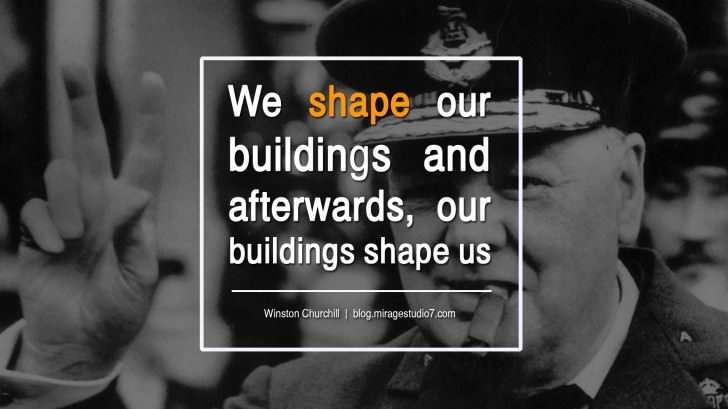
What do you see? What is above the woman’s head? What element is the backdrop? Researchers showed this image to people from East Africa, almost all of those took part in the experiment said the lady was balancing a box on her head, in an African culture where there are few angular visual cues, the group of people is seen sitting under a big tree. On the other hand, Westerners are used to corners and rectangular architecture, thus they are more likely to visualize the group of people in an indoor space and to interpret the rectangular shape above the lady’s head as a window opening.
The studies showed the influence of different culture and environment can have an effect on our visual perception, this theory was first explored by Robert Laws, a Scottish missionary working in Malawi, Africa, during the late 1800’s.
Winston Churchill’s epic statement, “We shape our buildings and afterwards, our buildings shape us,” is a fantastic observation of the architectural phenomenon, illuminating the fact that physical architecture is a static artifact and continues to transform us long after construction.
Coupled with Churchill’s famous quotes and the illusion above, does a person who comes from a third world posses the same creativity in architecture compared to say, someone whom was brought up in a historically rich city such as Paris?





Roman / Doric columns ARE an eye sore. Especially when they coupled with wooden houses. It’s like living in an architectural birth defect.
To you they may be anachronistic architectural elements, but to someone from Malaysia, they could be stand-ins for trees–very important in creating a sense of safety.
Not to forget, to the ‘tasteless’ the diameter of each of the columns are equivalent to their belly size, thus, reflecting how rich they are. That’s why my friend admitted her dad needs 6 roman columns in their driveway.
roman column is not a part of malaysian culture. So there’s no reason why we should be proud to have it in malaysian houses.
amazing…we have the same problem here in the Philippines…I thought the colonial mentality that western architecture is much preferred than our very own tried-and-tested, sustainable tropical architecture is only a problem found in my country…I see that there is also this type of problem in other places as well…I am an architecture student in the Philippines struggling against this mentality…
I am a doctoral candidate in sociology at UNM Makassar, Indoensia. The thesis/ dissertation I am writing is about “social construction by architecture”, which is a part of study of architectural sociology. This article remind me of what Chirchili had ever said 64 last years, in case of debate among parliamentarian about whether they need to build a new building or renovate the parliament building what demand by war: ” We shape the building, but finally the building is shaping us”. Interesting article, cladding
This foto from the slum near a luxury building was taken in my city, Sao Paulo, Brasil. It’s really a classic foto, very often used when talking about social… inequality?! sorry, not very good english…
you can’t say every country in the 3ed world beause i think egypt have alot of historically rich city such as giza,louxer,alexandria
This is really quite an interesting post, but talking about ‘social inequality’ of that photo from Brazil, I feel really astonished that someone would put a luxury hotel with pools on each level/balcony next to a slum. And the thing that’s really on my mind, is how come they haven’t given anything to the slum. Yet, for all i know, i could be completely wrong.
who is the architect of the building in sao paulo?who is the architect?
we have that phenomenon in indonesia, in my current place, theres a hotel and shopping center side by side with slum area, which is literally very close that my friends dorm was “below” the buiding
Does a person who comes from a third world posses the same creativity in architecture compared to say, someone whom was brought up in a historically rich city such as Paris?
Genetically of course! And of course on what’s both of them think Architecture is.
Yup, their definition of what is architecture is different.
ITS OBVIOUSLY A ROOM WITH A WINDOW, SHOW IT TO SOMEONE WHO HAVE NEVER BEEN INSIDE A ROOM THEY WILL NEVER RECOGNIZE THAT.
WHAT’S STRANGE ABOUT THAT